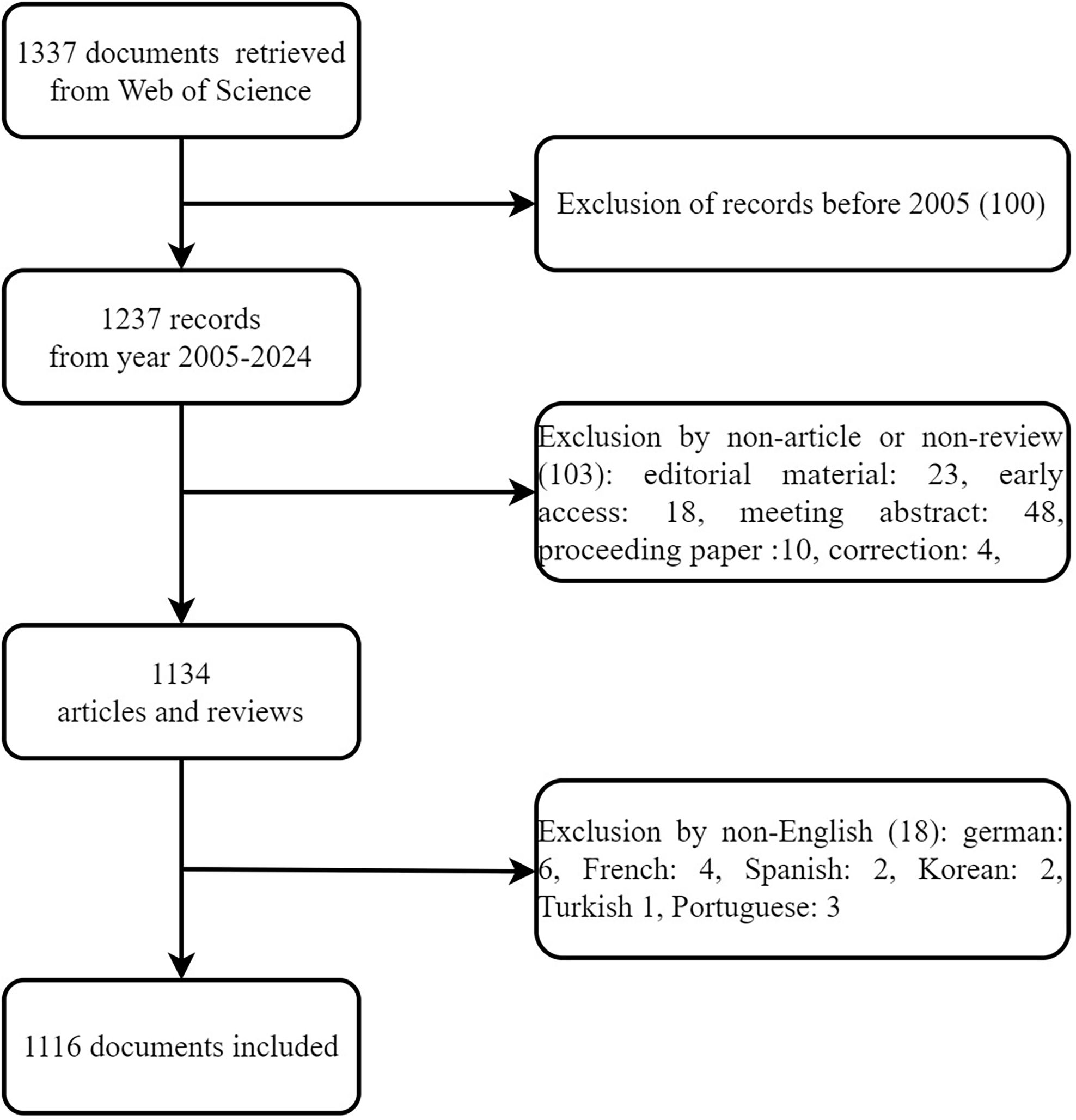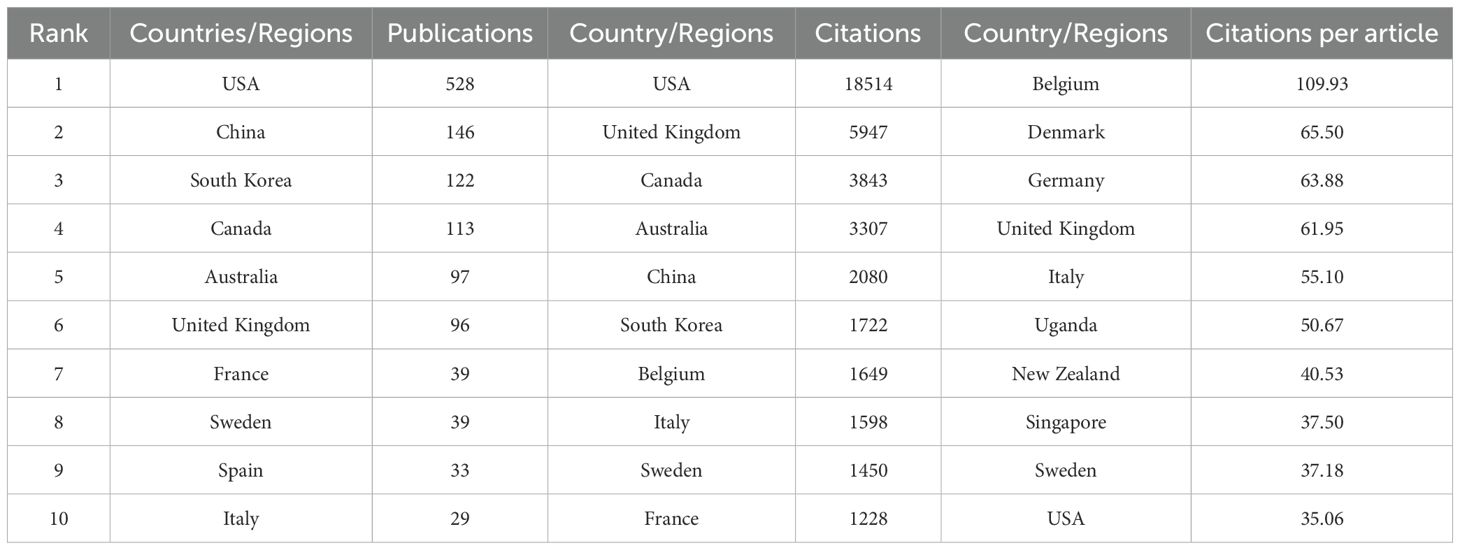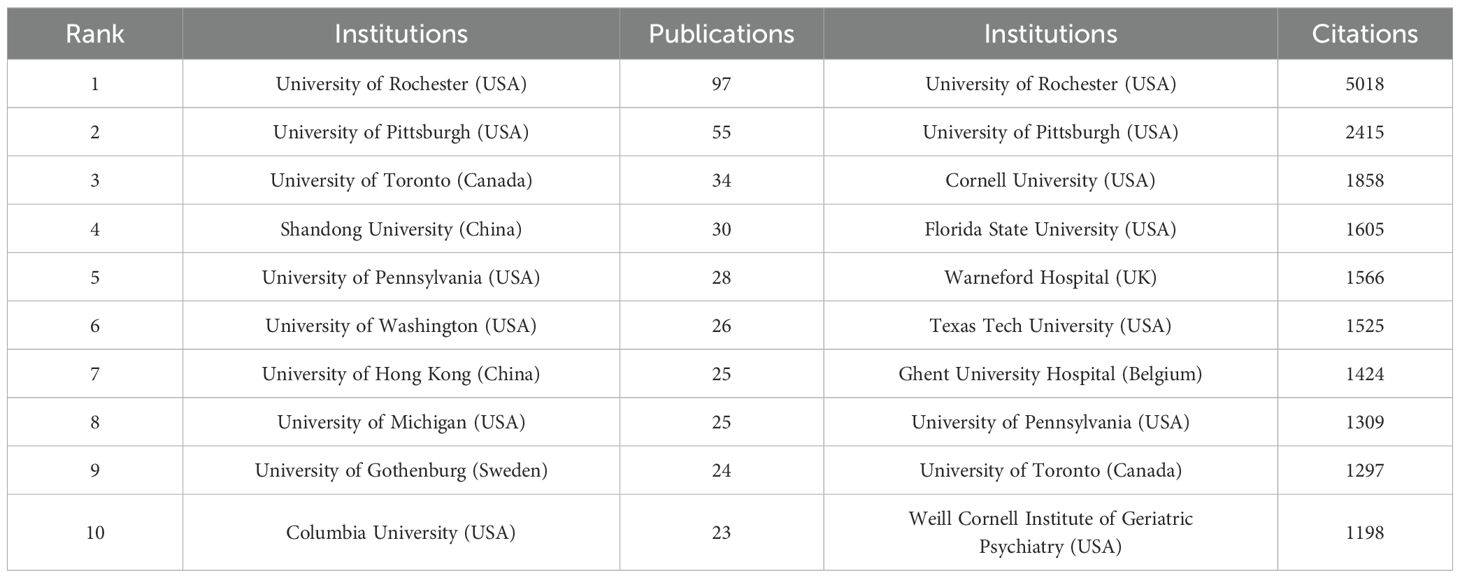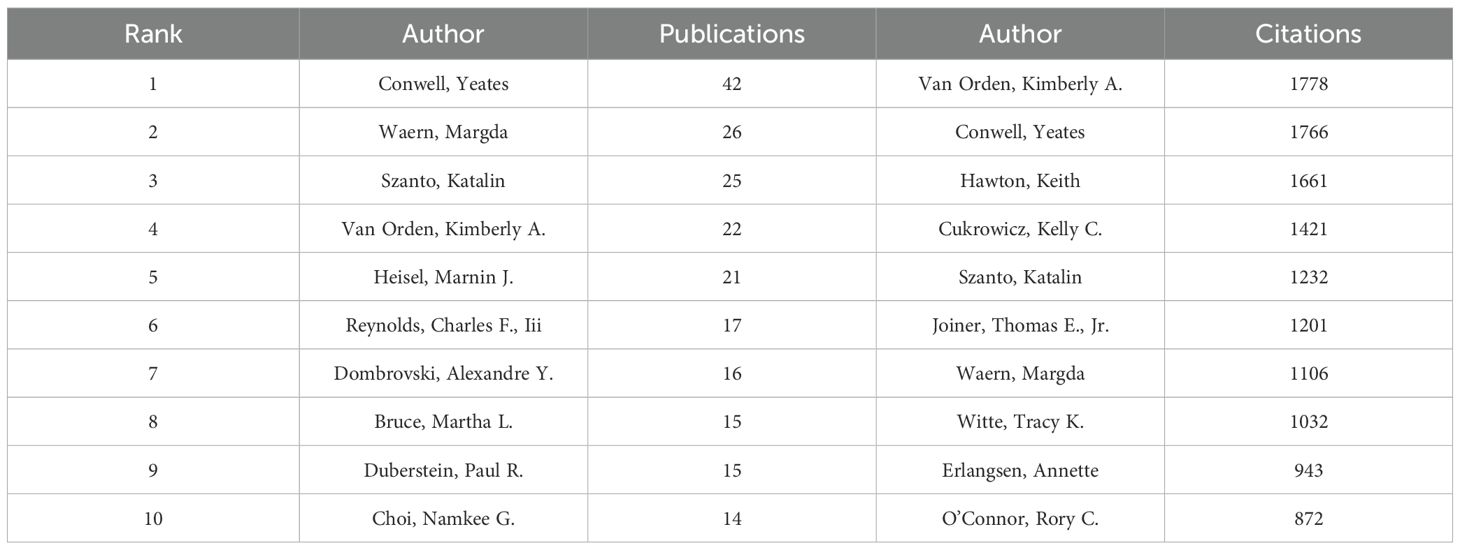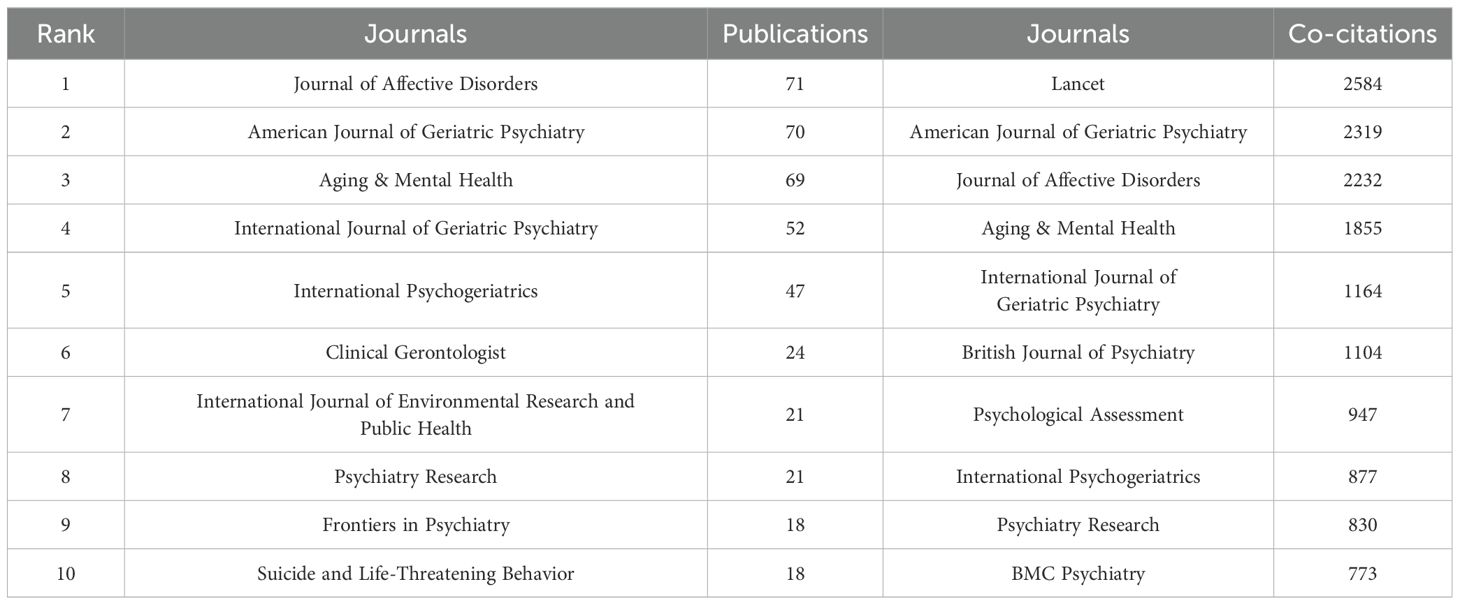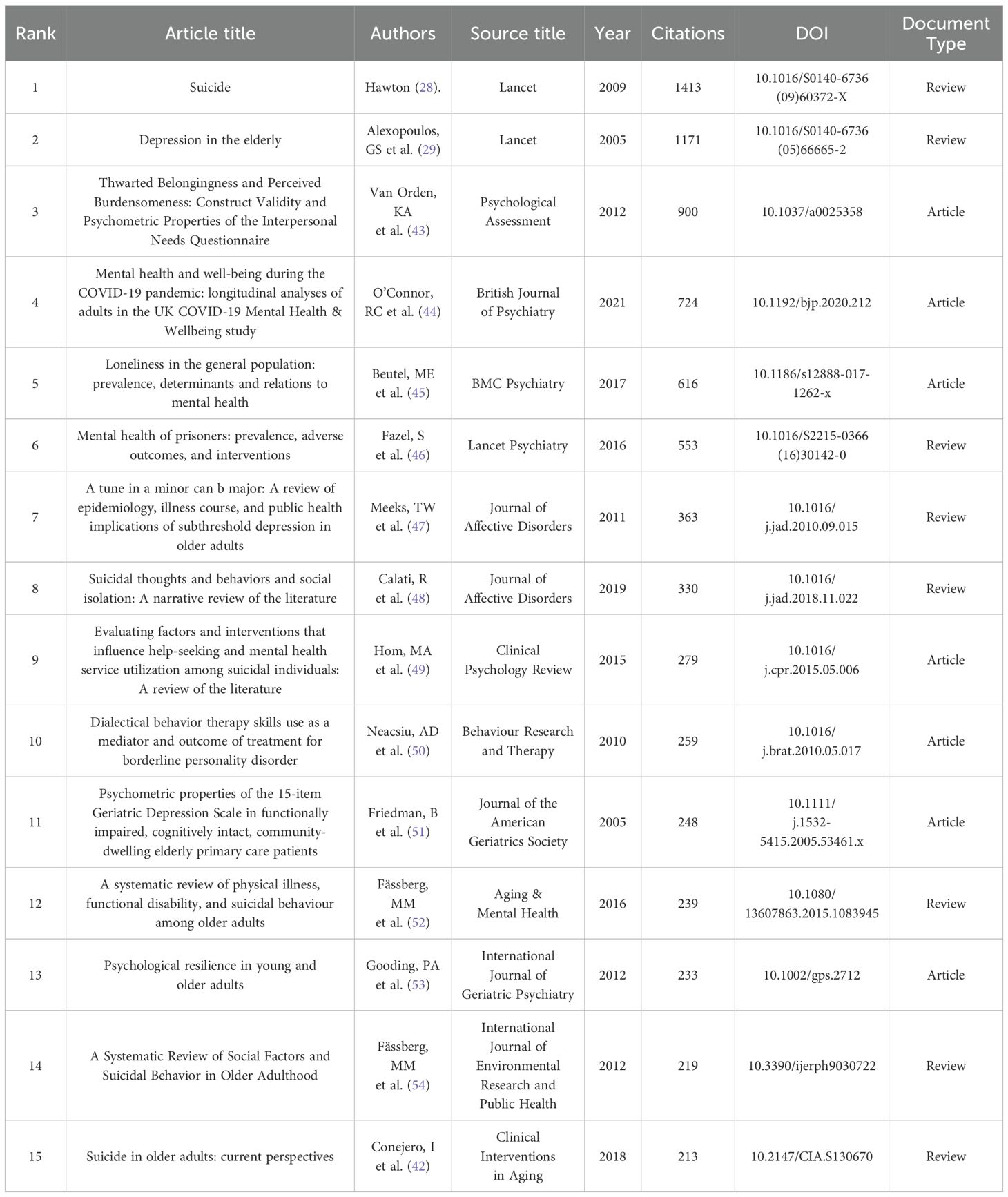- Depressive Disorders Ward I, Shenzhen Kangning Hospital/Shenzhen Mental Health Center, Shenzhen, China
Background: The rapid aging of the global population presents pressing public health challenges, notably an increase in suicide rates among older adults. Despite this critical issue, there is a scarcity of comprehensive assessments regarding the existing literature on suicide within this demographic. This study seeks to employ bibliometric analysis and knowledge mapping to elucidate prevailing research trends and the overall status of this field.
Methods: We performed a comprehensive computer-based search of the Web of Science Core Collection to identify relevant articles and reviews concerning suicide in the elderly. A bibliometric analysis was conducted, examining various aspects including countries or regions, institutions, authors, journals, keywords, and references. This analysis utilized tools such as CiteSpace, VOSViewer, Pajek, and Excel 365 to facilitate a thorough assessment.
Results: The analysis covered 1,116 publications from 2005 to 2024. The annual number of publications showed a fluctuating upward trend, with notable decreases in 2007, 2012, 2015, 2017, and 2022, and increases in 2009, 2013, 2016, and 2019, peaking at 121 in 2021, with citations reaching 4,741 in 2022, but declining since then. The United States stands out as the most productive and influential country in the field, boasting the highest number of publications and citations. The country is home to institutions leading in both publication and citation metrics. Prominent authors contributing significantly to this domain include Conwell Yeates, Van Orden Kimberly A., and Waern Margda. Key journals disseminating crucial research are the Journal of Affective Disorders, American Journal of Geriatric Psychiatry, and Lancet. Frequent keywords in this field encompass depression, suicidal ideation, suicide, older-adults, risk, risk factors, prevalence, older adults, ideation, behavior, health, mental health, life, age, people, prevention, symptoms, scale, population, and elderly. The contemporary research emphasis is primarily on identifying, treating, and preventing the suicide risk associated with depression in older adults.
Conclusions: This study highlights the growing research focus on suicide in older adults, particularly related to depression and the identification, treatment, and prevention of suicide risk. The findings underscore the need for targeted prevention strategies and further investigation in this critical public health area.
1 Introduction
According to a World Population Prospect (1), by 2030, one in six people worldwide will be aged 60 or older. By 2050, the number of individuals aged 60 and above will double from 2020 levels, reaching 2.1 billion. It is projected that between 2020 and 2050, the population of those aged 80 and above will triple, reaching 426 million. Meanwhile, suicide remains a serious public health issue, causing approximately 700,000 deaths globally each year (2). Of these deaths, around one quarter (27.2%) occur among individuals aged 60 and above (3).
Klonsky et al. (4) proposed the ideation-to-action Three-Step Theory, which outlines the progression from suicidal ideation to strong ideation and ultimately a suicide attempt. Previous research (5) has identified female gender, history of smoking, lack of income, depressive symptoms, and heart disease as predictors of suicidal ideation in the elderly. Among older adults with suicidal ideation, 6% to 20% attempt suicide (6). According to the life course development theory (7), as elderly individuals experience a decline in physical function and reduced opportunities for life control, those who fail to adapt to these changes may face a higher risk of suicide. Elderly individuals who attempt suicide exhibit higher suicidal intent and greater medical lethality, with disease-related issues strongly motivating their suicidal behavior (8). Studies have found that over 90% of those who complete suicide are diagnosed with severe mental illness, and 50% suffer from depression at the time of their suicide (9). Depression is a major risk factor for suicide (10–13). A Swedish cohort study found that the risk of suicide in individuals with depression is more than 15 times higher compared to the general population. Notably, during the first three months following a diagnosis, this risk increases to 32 times higher (14). This elevated risk is even more pronounced in the elderly population (15). Additionally, a history of previous suicide attempts in individuals with depression further indicates a higher likelihood of future suicide risk (16). Furthermore, the severity of depression is strongly associated with suicide risk (11, 17, 18). Elderly individuals with moderate to severe depression, as measured by the eight-item Patient Health Questionnaire depression scale (PHQ-8≥15), are 48 times more likely to experience suicidal ideation compared to those with minimal or mild depressive symptoms (PHQ-8 <10) (17).
Cognitive impairment is commonly observed among elderly individuals who commit suicide. Late-stage dementia typically does not accompany an increased risk of suicide, as the decline in cognitive abilities prevents patients from recognizing their condition and limits their behavioral choices (19). However, patients with early-stage dementia often experience distress due to their awareness of cognitive changes and fear of future limitations, which may increase their suicide risk (19). Previous study (19) has indicated that individuals with mild cognitive impairment or early-stage dementia are at an increased risk of attempted suicide, particularly within the first 90 days and the first year following diagnosis. Additionally, executive dysfunction is associated with a sevenfold increase in the risk of suicide (20). However, it does not significantly impact suicidal ideation or suicide attempts (20).
Bibliometrics employs qualitative and quantitative methods to analyze, assess, and manage literature and information resources, integrating techniques from information science, statistics, and computer science to measure the productivity, impact, and trends of scientific research (21). Bibliometrics involves the analysis of various indicators, including citation analysis, author collaboration networks, international research partnerships, institutional collaborations, journal citation patterns, and the evolution of research themes. This field aids researchers and policymakers in understanding the dynamic landscapes of academic disciplines, thereby facilitating the development of research strategies and the allocation of resources. Currently, suicide among the elderly is primarily associated with depression, and significant research findings have emerged over the past 20 years; however, bibliometric analyses in this area remain sparse. This study seeks to undertake a comprehensive bibliometric analysis of research related to suicide in the elderly, employing advanced bibliometric software tools including VOSviewer, Pajek, and CiteSpace. The goal is to uncover trends and emerging themes from the last two decades, facilitating a deeper understanding of the evolving landscape within this scholarly domain. The insights gained from this analysis will be instrumental for researchers and policymakers in shaping strategic research initiatives and optimizing resource allocation.
2 Materials and methods
2.1 Search strategy and data retrieval
The data for the bibliometric analysis conducted in this study were obtained from the Web of Science Core Collection (WOSCC). Recognized for its comprehensiveness and standardization, WOSCC is extensively used in academic research (22). Our retrieval methodology employs “TS=(“old* people” OR “old* adult*” OR “old* person” OR “old* population” OR “elder* people” OR “elder* adult*” OR “elder* population” OR “aged people” OR geriatric* OR Centenarians OR Nonagenarians OR Octogenarians)” AND TS=(“Suicid* Ideation” OR “Suicid* Assisted” OR “Suicid* Attempt*” OR “Suicid* Completed” OR “Suicid* Prevention”). The latest update to the search was performed on July 2, 2024, encompassing publications from January 1, 2005, to July 2, 2024. A total of 1,116 English-language documents, classified solely as “articles” and “reviews,” were selected for analysis. These documents were subsequently exported in plain text format for in-depth analysis.
2.2 Statistical analysis and visualization of data
For comprehensive visual analyses, we employed several tools: CiteSpace 6.3.R3 Advanced by Chaomei Chen (23), VOSviewer by Nees Jan van Eck and colleagues (24), and Pajek software by Batagelj, V et al. (25). Key information such as titles, authors, affiliations, countries or regions, publication journals, keywords, and references were extracted to visualize collaboration networks among countries, institutions, and authors. We also created keyword co-occurrence networks, keyword timelines, and conducted co-citation analyses for authors, journals, and references. Data aggregation, organization, and visualization were performed using Microsoft 365 Excel. As the data used in this study were sourced from public databases, no ethical review was necessary.
3 Results
3.1 Retrieval diagram, annual publications, and citations
Between 2005 and 2024, our search yielded 1,337 records, all of which were English-language articles and reviews. After a thorough screening process, 1,116 documents were included in the final analysis (Figure 1). Figure 2 illustrates the annual publication trends and citation frequencies of articles concerning suicide in elderly adults over the past 20 years. The annual number of publications exhibited a fluctuating upward trend. Notable decreases were observed in 2007, 2012, 2015, 2017, and 2022, followed by increases in 2009, 2013, 2016, and 2019. Since 2022, the trend has been declining. The annual publication count peaked at 121 in 2021, while citation frequencies reached their highest point of 4,741 in 2022.
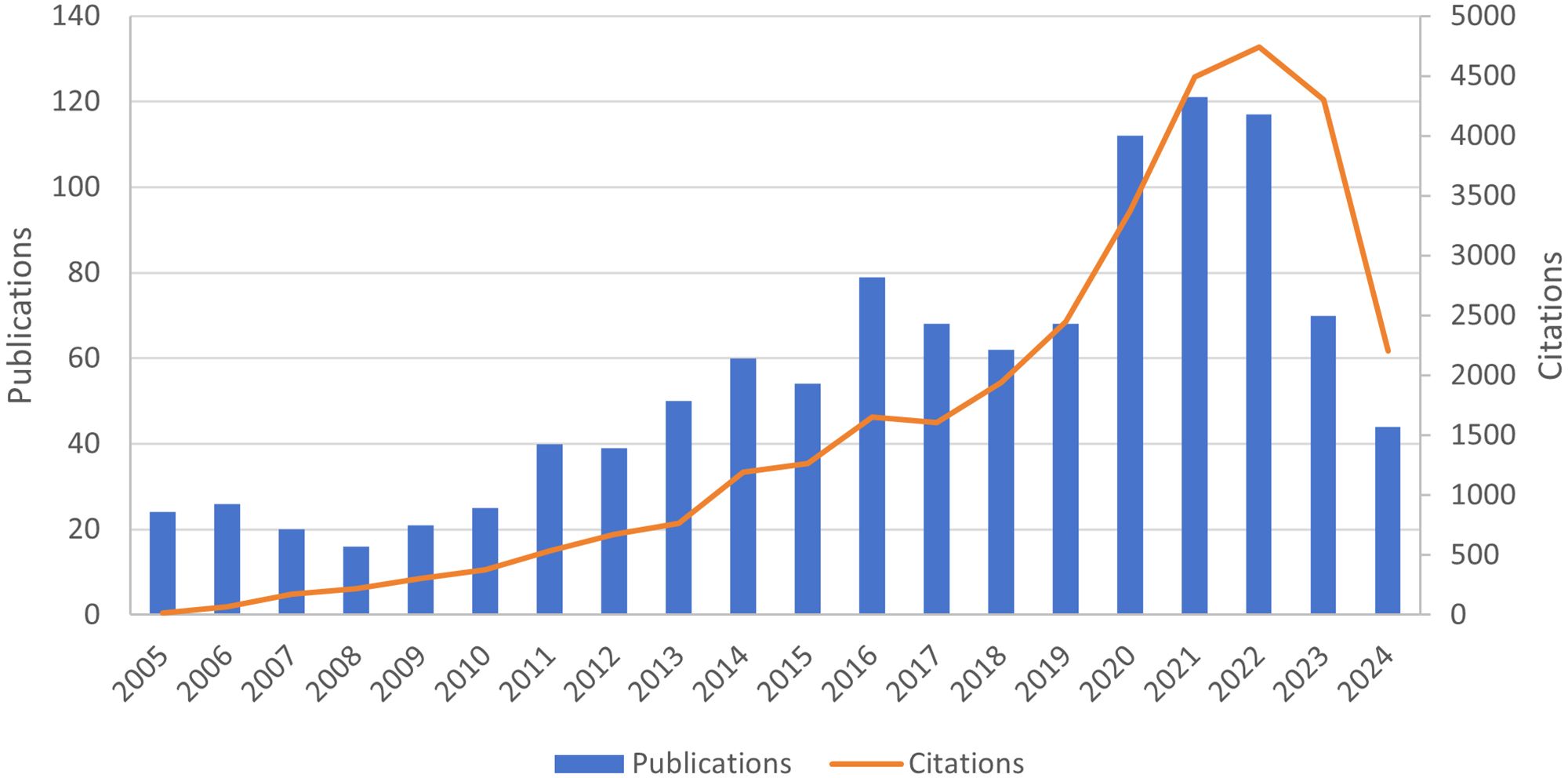
Figure 2. The annual number of publications and citations of relevant articles from 2005 to 2024, with data for 2024 updated until July 2.
3.2 Distribution of countries or regions
Research on suicide in the elderly people encompasses contributions from 56 countries or regions. Table 1 showcases the top 10 countries or regions, ranked by publication volume, citation frequency, and average citations per article. The United States (USA) leads in publication volume with 528 articles, followed by China with 146 articles. South Korea and Canada come next with 122 and 113 articles, respectively, while all other countries and regions have fewer than 100 publications each. In terms of citation frequency, the USA again ranks first with 18,514 citations, followed by the United Kingdom with 5,947 citations, Canada with 3,843 citations, and Australia with 3,307 citations. All remaining countries and regions have fewer than 3,000 citations each. Belgium leads with the highest average citations per article at 109.93, followed by Denmark at 65.50, Germany at 63.88, the United Kingdom at 61.95, Italy at 55.10, and Uganda at 50.67. Average citations per article for all other countries or regions are below 50.
Figure 3 visualizes the collaborative dynamics among countries and regions engaged in research on suicide in the elderly using VOSviewer. Countries and regions are clustered based on the intensity of their collaboration, depicted in different colors. For instance, the red cluster includes South Korea, United Kingdom, France, Sweden, Spain, Italy, and others, while the green cluster encompasses the USA, China, Canada, Australia, Israel, New Zealand, and additional countries. Node sizes correspond to publication volumes, with larger nodes representing countries like the USA, China, United Kingdom, Canada, France, and Australia. The thickness of connecting lines indicates the strength of inter-country collaborations. The results highlight strong partnerships, particularly between the USA and countries such as China, Australia, and Canada, emphasizing their significant roles in advancing research on suicide in the elderly.
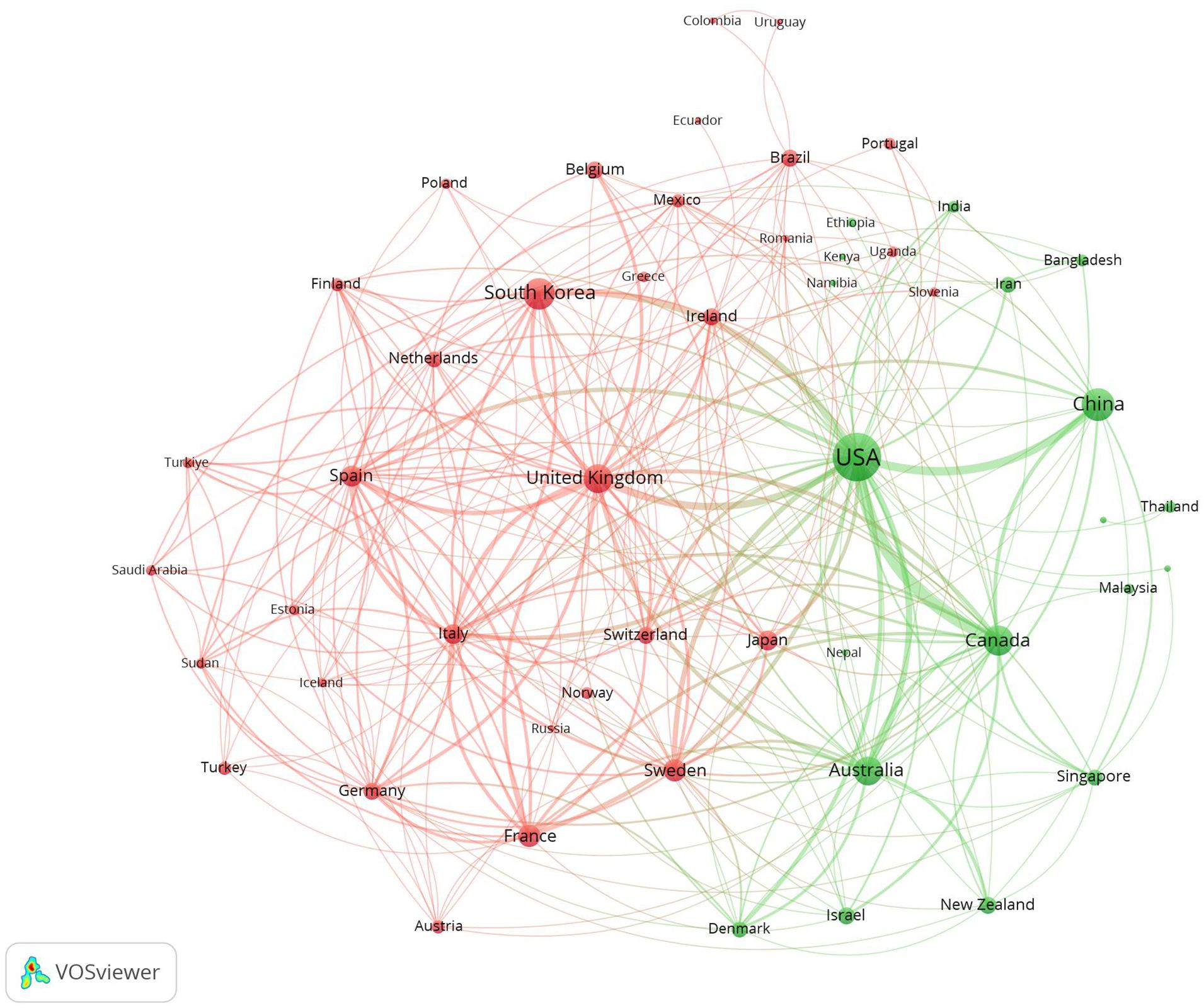
Figure 3. Collaboration networks among countries/regions were visualized using VOSviewer. Nodes are color-coded to represent distinct clusters, with node size indicating the relative prominence of each country/region.
3.3 Distribution of institutions
Research on suicide among the elderly involves 1,492 affiliations. Table 2 highlights the top 10 affiliations based on publication frequency and citation impact. The University of Rochester leads with 97 publications, followed by the University of Pittsburgh with 55, the University of Toronto with 34, and Shandong University with 30. Other institutions each have fewer than 30 publications. In terms of citation impact, the University of Rochester also stands out with 5,018 citations, followed by the University of Pittsburgh with 2,415 citations, Cornell University with 1,858, Florida State University with 1,605, Warneford Hospital with 1,566, and Texas Tech University with 1,525. The remaining institutions each have fewer than 1,500 citations.
Figure 4 visually represents the collaborative network among institutions engaged in research on suicide in the elderly. Utilizing VOSviewer, the analysis categorizes these institutions into five distinct circles, each represented by a different color to indicate the intensity of their collaborative relationships. The red cluster encompasses renowned institutions such as the University of Rochester, University of Pittsburgh, University of Toronto, and University of Western Ontario. In contrast, the green cluster includes Seoul National University, Yonsei University, Anglia Ruskin University, and Bezmialem Vakif University. Within the blue cluster are prominent institutions like the University of Gothenburg, University of Melbourne, King’s College London, and the University of Sydney. The yellow cluster features esteemed universities such as the University of Washington, Duke University, University of Michigan, and the University of California, Los Angeles. Lastly, the purple cluster comprises the University of Tokyo, National Taiwan University Hospital, National Center of Neurology and Psychiatry, and Emory University.
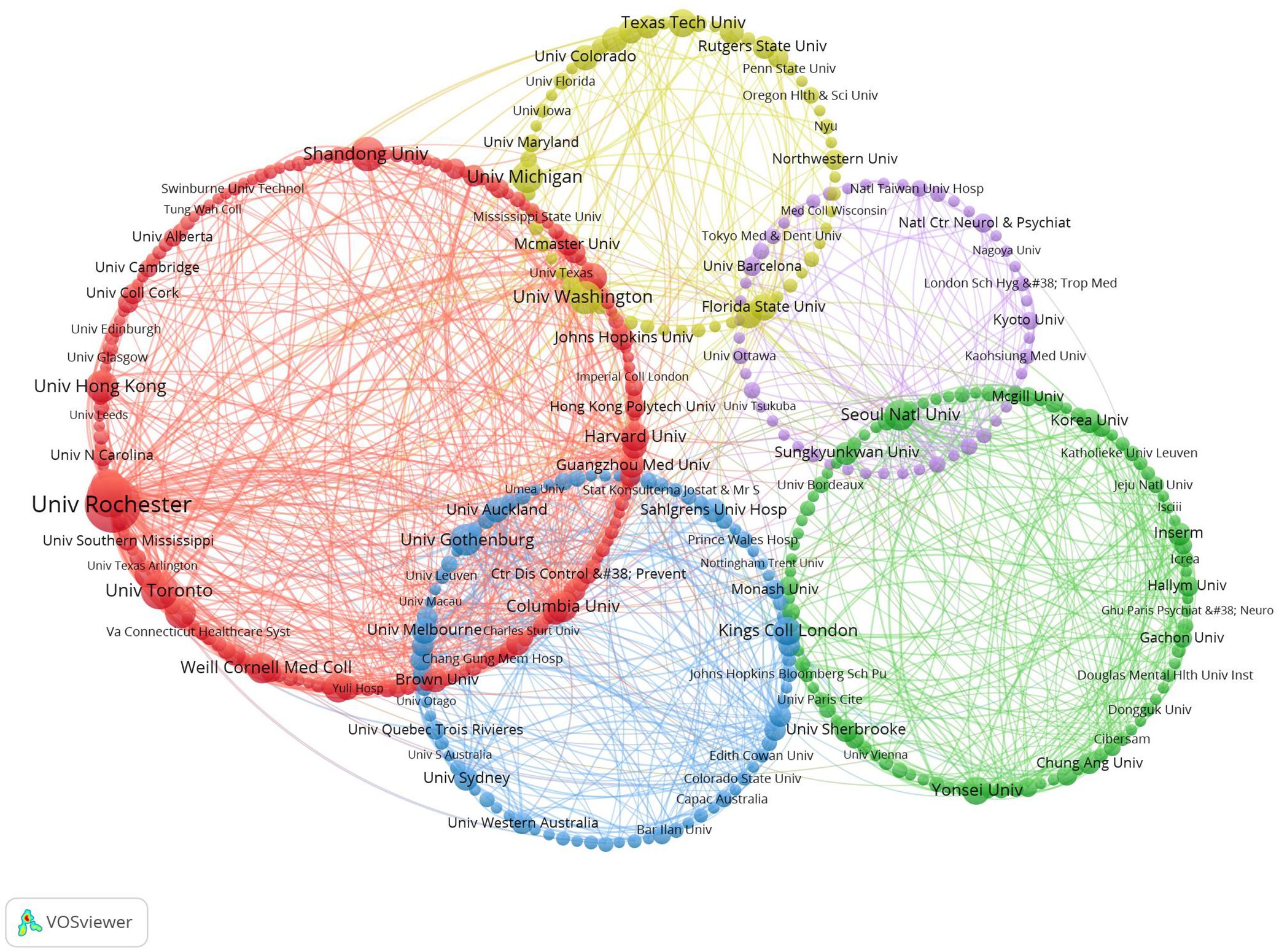
Figure 4. Collaboration networks among institutions were visualized using VOSviewer and Pajek. Nodes of different colors represent distinct institutional clusters, and the size of each node reflects the frequency of occurrence.
These institutions serve as central hubs within their respective clusters, demonstrating robust collaborative connections. Node sizes reflect publication volumes, highlighting significant contributors like the University of Rochester, Seoul National University, University of Gothenburg, University of Tokyo, and University of Washington, which have made substantial impacts in this field of research.
3.4 Distribution of authors
Examining the authors who have made significant contributions to research on suicide in the elderly reveals both the prominent figures and prevailing trends in this field. A total of 4119 authors have participated in studies related to this topic. Table 3 highlights the top 10 authors based on their publication records and citation frequencies. Conwell Yeates leads with 42 publications, followed by Waern Margda26, Szanto Katalin25, Van Orden Kimberly A with 22 publications, and Heisel Marnin J with 21 publications. All other authors have published fewer than 20 papers. In terms of citation frequencies, Van Orden Kimberly A holds the top position with 1778 citations, followed by Conwell Yeates with 1766 citations and Hawton Keith with 1661 citations. The remaining authors have been cited fewer than 1500 times each.
Figure 5A visually maps the collaborative network among authors engaged in research on suicide in the elderly. Using VOSviewer, authors are categorized into four distinct clusters based on their collaborative strength, each marked by a unique color. The red cluster features prominent authors such as Draper Brian, Koyanagi Ai, and Heisel Marnin J. The green cluster includes Waern Margda, Szanto Katalin, and Reynolds Charles F III. In the blue cluster, notable authors include Conwell Yeates, Van Orden Kimberly A, and Kim Jae-Min. The size of each node corresponds to the publication volume of the respective authors, while the thickness of the connecting lines indicates the strength of their collaborative relationships. Notably, authors with significant publication volumes include Conwell Yeates, Marti C Nathan, Bruce Martha L, and Heisel Marnin J.
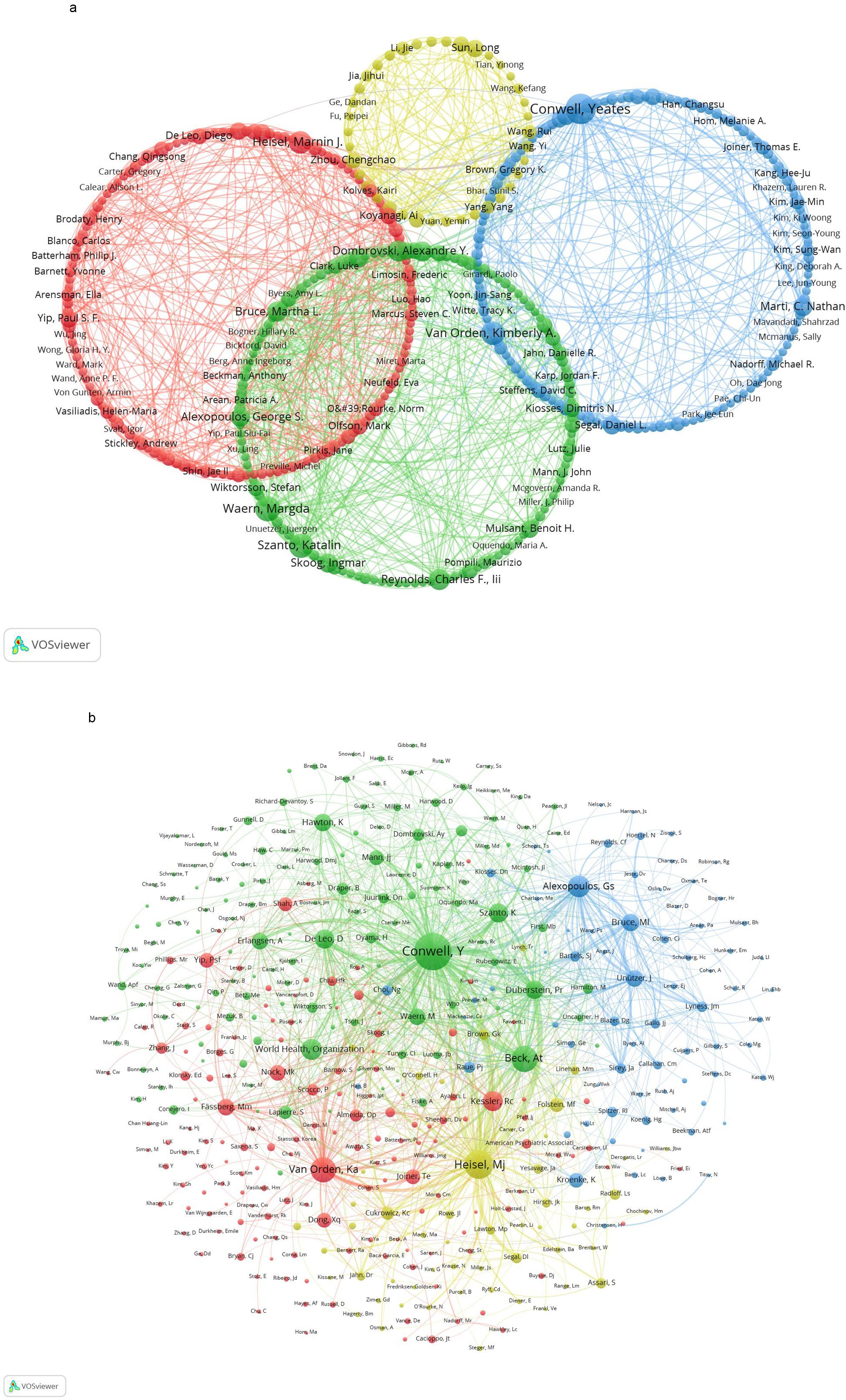
Figure 5. Analysis of authors related to suicide in older adults. (A) Collaboration networks among authors were visualized using VOSviewer and Pajek. Nodes of different colors represent authors within distinct clusters, and node size corresponds to the frequency of occurrence. (B) Citation networks among authors were visualized using VOSviewer, with node size indicating the frequency of occurrence.
Figure 5B illustrates the co-citation network among authors in the field, analyzed using VOSviewer. Authors are grouped into four primary clusters based on the strength of their co-citation relationships, each represented by a unique color. The red cluster includes prominent authors such as Van Orden KA, Kessler RC, and Joiner TE. In the green cluster, notable figures include Conwell Y, Beck AT, and Duberstein PR. The blue cluster comprises authors like Alexopoulos GS, Bruce ML, and Raue PJ. The yellow cluster encompasses authors such as Heisel MJ, Cukrowicz KC, and Folstein MF. Each cluster’s size corresponds to the frequency of co-citations among its authors, with larger circles indicating stronger co-citation weights. These authors are among the most frequently cited within their respective clusters.
3.5 Distribution of journals
Research on elderly related to suicide is published across 323 journals, detailed in Table 4 which ranks the top 10 journals by both publication volume and citation frequency. Leading journals in terms of publications include Journal of Affective Disorders with 71 articles, American Journal of Geriatric Psychiatry with 70 articles, Aging & Mental Health with 69 articles, and International Journal of Geriatric Psychiatry with 52 articles. Other journals have published fewer than 50 articles each. The most cited journals include Lancet with 2584 citations, American Journal of Geriatric Psychiatry with 2319 citations, and Journal of Affective Disorders with 2232 citations, while other journals have citation frequencies below 2000.
Figure 6A illustrates the network of journals that publish research articles on suicide-related elderly, analyzed using VOSviewer to visualize their interconnections. These journals are grouped into 3 distinct clusters identified by different colors, which represent their thematic similarities. The red cluster includes journals such as Aging & Mental Health, The Gerontologist, and The Journals of Gerontology Series B: Psychological Sciences. In the green cluster, you find Journal of Affective Disorders, Suicide and Life-Threatening Behavior, and British Journal of Psychiatry. The blue cluster encompasses American Journal of Geriatric Psychiatry, American Journal of Psychiatry, and International Journal of Geriatric Psychiatry.
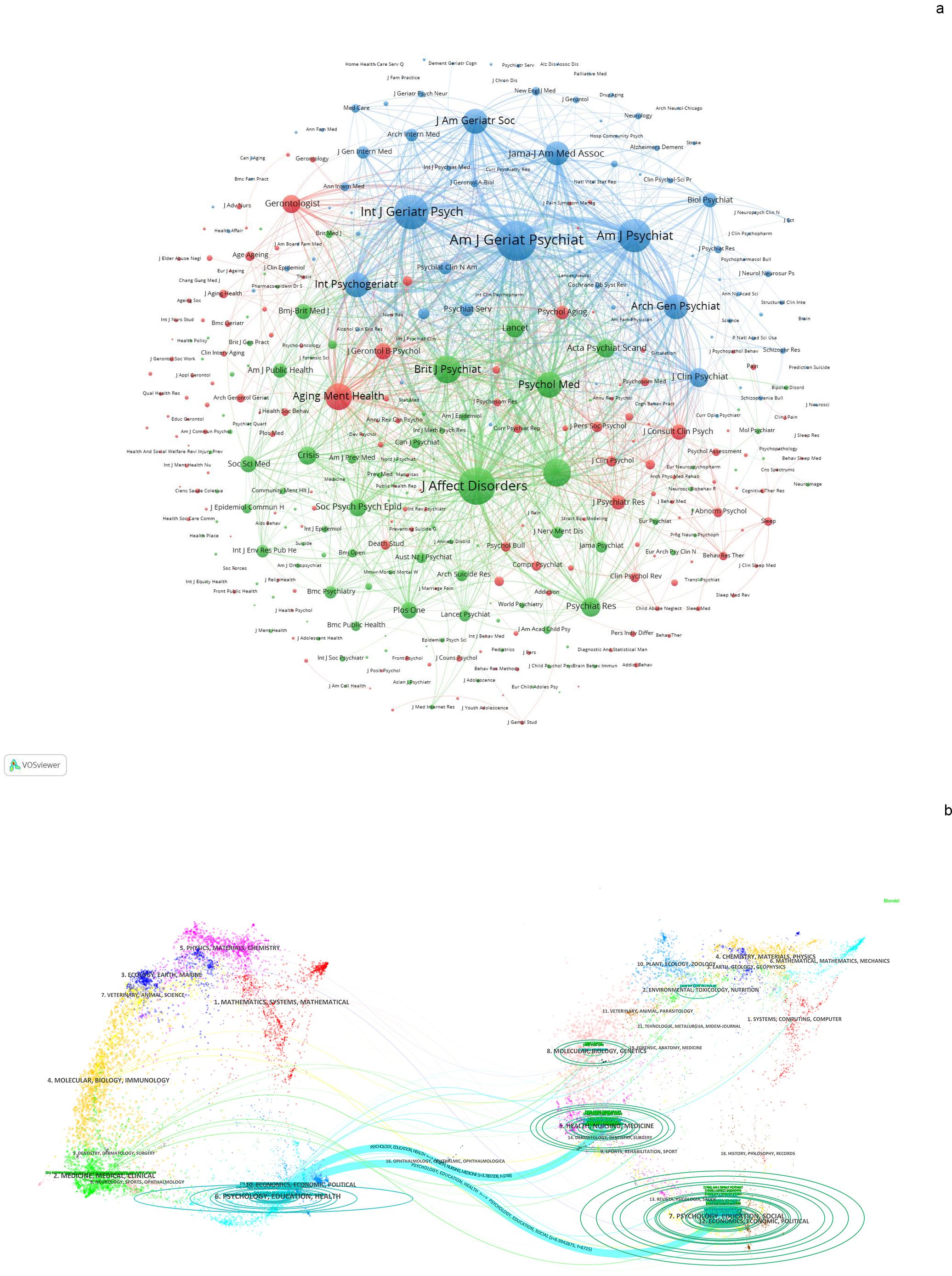
Figure 6. Analysis of authors and journals related to suicide in older adults. (A) Collaboration networks among journals were visualized using VOSviewer. Nodes of different colors represent journals within distinct clusters, and node size reflects their frequency of occurrence. (B) A dual-map overlay of journals is presented, with citing journals on the left and cited journals on the right. Colored pathways illustrate citation relationships.
Knowledge flow analysis was utilized to explore the evolution of citation and co-citation patterns among journals, examining how they influence each other over time (26). The dual-map overlay of journals provides a visual representation of how topics are disseminated, citation pathways are established, and research focal points shift across academic literature (26, 27). On the left side of the Dual-map, labels represent journals citing others, while those on the right denote journals being cited. The colored curves connecting the citing map to the cited map visually depict the comprehensive context of each citation. In the citing map, the vertical axis of the ellipse expands with an increasing number of papers published by a journal, while the horizontal axis expands corresponding to a larger number of authors involved. Citing journals predominantly cover topics in fields such as PSYCHOLOGY, EDUCATION, HEALTH, MEDICINE, MEDICAL, and CLINICAL, representing the forefront of research. The topics addressed by cited journals mainly encompass areas like PSYCHOLOGY, EDUCATION, SOCIAL, HEALTH, NURSING, MEDICINE, MOLECULAR, BIOLOGY, GENETICS, ENVIRONMENTAL, TOXICOLOGY, NUTRITION, forming the foundational knowledge base in Figure 6B.
3.6 Analysis of keywords
Keywords play a pivotal role in navigating the cutting-edge research landscape of suicide-related elderly. Figure 7A highlights the top 20 frequently cited keywords, providing a comprehensive glimpse into the forefront of this field. Leading the list is depression, followed by suicidal ideation, suicide, older-adults, risk, risk-factors, prevalence, older adults, ideation, behavior, health, mental-health, life, age, people, prevention, symptoms, scale, population, and elderly. The top 20 keywords are mentioned between 87 and 467 times, whereas all other keywords appear less frequently, each below 87 occurrences.
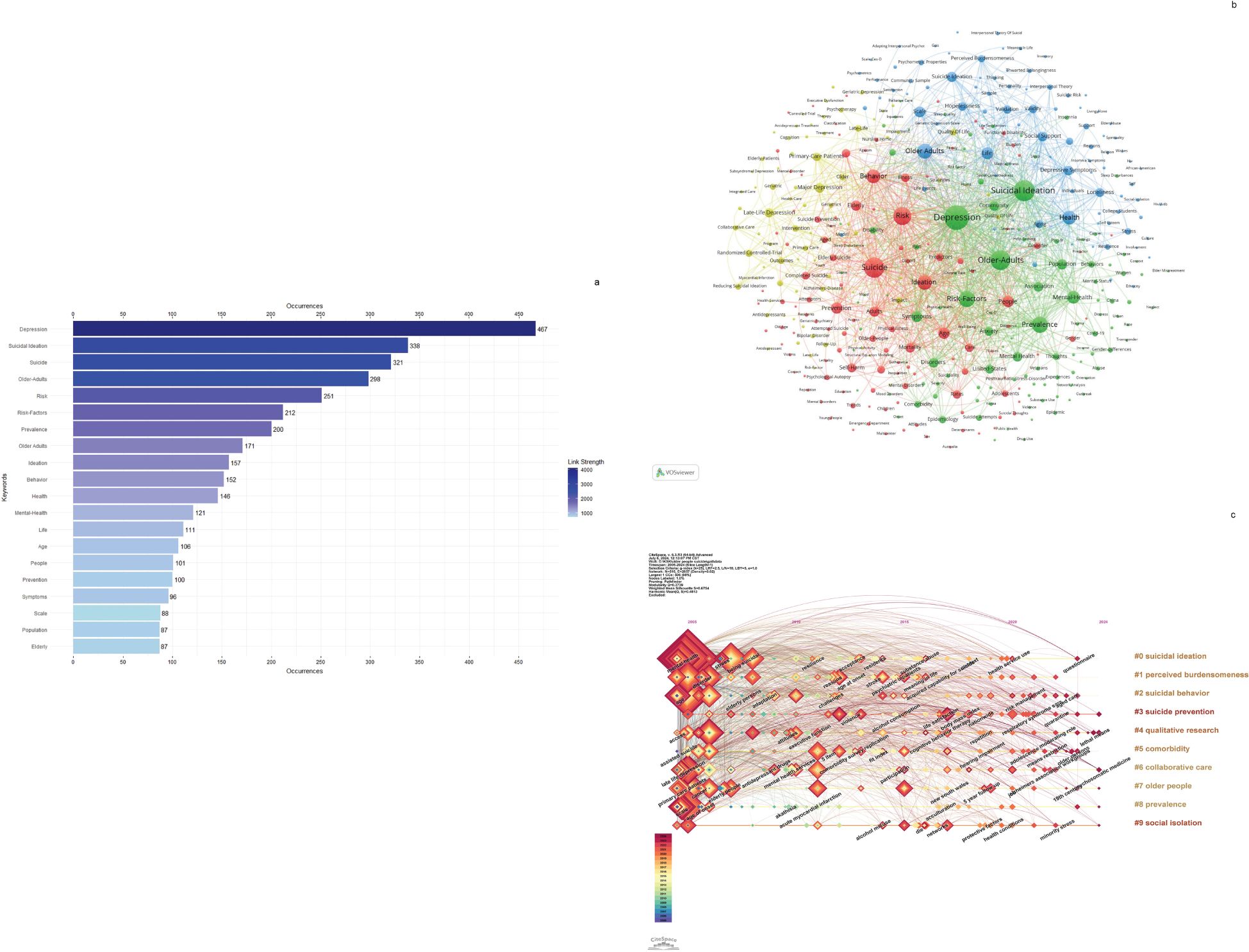
Figure 7. (A) The top 20 most frequently occurring keywords and their link strengths. (B, C) Analysis of keywords related to suicide in older adults. (B) Keyword co-occurrence networks were visualized using VOSviewer, with nodes in different colors representing distinct keyword clusters. Node size reflects their frequency of occurrence. (C) A visual timeline created with CiteSpace depicts the evolutionary emergence of these keywords, with the size of each square indicating their frequency over time.
Figure 7B depicts a network of keyword co-occurrences, where closely related terms are organized into 4 distinct clusters distinguished by different colors. The red cluster encompasses terms such as suicide, risk, ideation, behavior, and age. In the green cluster, you find keywords like depression, suicidal ideation, older adults, risk factors, and prevalence. The blue cluster includes terms such as older adults, health, life, and scale. The yellow cluster comprises major depression, late-life depression, and primary care patients.
Figure 7C provides a visual timeline depicting the evolutionary emergence of these keywords, where the size of each square corresponds to how frequently it appears over time. The keywords listed in the right column are aligned with the thematic clusters observed on the left.
3.7 Analysis of reference
Table 5 presents the top 15 most frequently cited articles, with the leading article (28), titled “Suicide” published in the Lancet, having been cited 1,413 times. This article provides a comprehensive analysis of the global landscape of suicide and prevention strategies. It highlights the significant prevalence of psychiatric disorders among those who die by suicide and underscores the numerous challenges faced in implementing effective suicide prevention measures, particularly in developing countries. The article (29) titled “Depression in the Elderly,” which appears in the Lancet, ranks second in citation frequency with a total of 1,171 citations. This article examines the prevalence and impact of depression among the elderly, focusing on its association with chronic medical conditions, cognitive impairment, and psychosocial stressors. It also evaluates the effectiveness of antidepressant treatments and highlights the inadequacies of public insurance coverage for these services in North America. The remaining articles in the top 15 by citation frequency have each garnered fewer than 1,000 citations.
Reference co-citation analysis, which examines the interrelationships among references based on their shared citation frequencies, was utilized to identify citation patterns. Figure 8A displays a relational diagram that illustrates these connections among studies, organized into three main clusters, each distinguished by unique colors. In the red cluster, foundational references include Conwell Y 2011 (30), Lapierre S 2011 (31), and Almeida OP 2012 (32). The green cluster features references such as Conwell Y 2002 (33), Bruce ML 2004 (34), and Beck AT 1979 (35). The blue cluster comprises references including Van Orden KA 2010 (36), Folstein MF 1975 (37), and Heisel MJ 2006 (38). The figure demonstrates that the size of each circle reflects its co-citation weight, representing the relative importance of these references within their respective color-coded clusters.
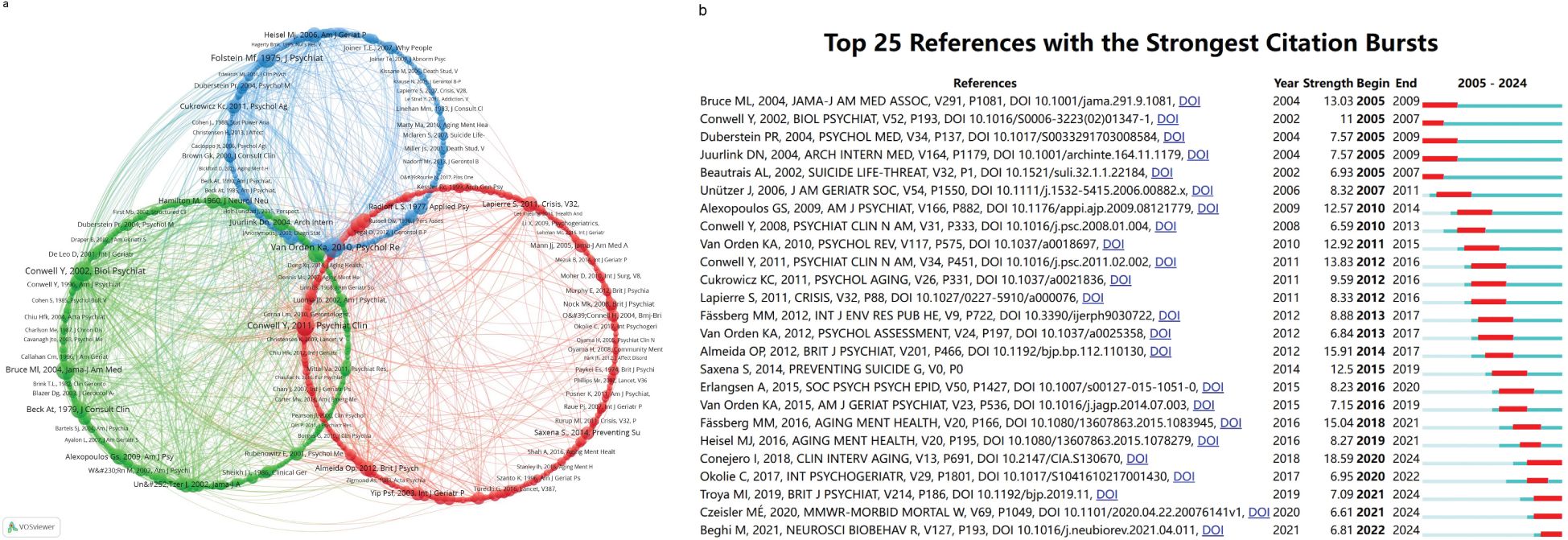
Figure 8. (A) Citation networks among references were visualized using VOSviewer and Pajek, with node size representing the frequency of occurrence. (B) The top 25 references exhibiting the strongest citation bursts.
Figure 8B illustrates the top 25 references with significant citation bursts, with 2005 standing out as both the year with the highest number of citation bursts, totaling five, and the year that saw the earliest burst. Notably featured is the study by Bruce ML et al. (34), titled “Reducing Suicidal Ideation and Depressive Symptoms in Depressed Older Primary Care Patients: A Randomized Controlled Trial,” published in 2004 in JAMA. This study evaluates the Prevention of Suicide in Primary Care Elderly: Collaborative Trial (PROSPECT), a randomized controlled trial that assessed the impact of a tailored primary care intervention on suicidal ideation and depression among older adults. It found that the intervention significantly reduced suicidal ideation and improved depression outcomes compared to usual care, highlighting its potential as an effective prevention strategy in late life. In 2005, four other significant studies also experienced notable citation bursts. These include the study by Conwell et al. (33) from 2002, titled “Risk Factors for Suicide in Later Life”; the research by Duberstein et al. (39) from 2004, “Suicide at 50 Years of Age and Older: Perceived Physical Illness, Family Discord, and Financial Strain”; the 2004 paper by Juurlink et al. (40), “Medical Illness and the Risk of Suicide in the Elderly”; and the 2002 article by Beautrais AL et al. (41), “A Case-Control Study of Suicide and Attempted Suicide in Older Adults.” These studies collectively highlight critical insights into suicide risk among older adults. They identify affective disorders, physical illnesses, and psychosocial factors—such as family discord and limited social networks—as significant contributors to suicide risk. Effective prevention strategies should focus on improving detection and treatment of mood disorders, addressing severe physical illness, and mitigating financial and social stressors. The research underscores the importance of tailored interventions and the need for further studies to refine understanding of these risk factors. The paper by Conejero I et al (42), titled “Suicide in Older Adults: Current Perspectives,” achieved the highest citation burst intensity of 18.59 in 2018. This narrative review evaluates recent findings on suicide risk factors in older adults, emphasizing the roles of psychiatric and neurocognitive disorders, social exclusion, and chronic physical illnesses. It underscores the necessity of integrating these factors into prevention models and adapting chronic care approaches to better address depression and suicidal behaviors in older populations.
4 Discussion
Our bibliometric analysis of suicide in the elderly employs VOSviewer, Pajek, and CiteSpace, examining publications from January 1, 2005, to July 2, 2024. This study includes contributions from 56 countries or regions, 1,492 institutions, and 4,119 authors. Our findings indicate that publication output peaked at 121 papers in 2021, while citation frequency reached its highest point of 4,741 in 2022 (Figure 2). The peak in publication volume and citation frequency aligns with the significant increase in suicide rates among individuals aged 65 and older in 2022 (55). Subsequently, both publication numbers and citation rates have experienced varying degrees of decline in the following years. This may be related to the implementation of effective suicide intervention measures in several countries, such as the launch of the 988 Suicide & Crisis Lifeline by the U.S. Department of Health and Human Services’ Substance Abuse and Mental Health Services Administration (SAMHSA).
The analysis of countries or regions reveals that in the field of suicide in the elderly, the USA significantly outpaces other nations in both publication volume and citation frequency, establishing itself as the most influential country in this domain (Table 1). Additionally, among the top 10 institutions by publication volume, 6 are based in the USA, and among the top 10 institutions by citation frequency, 7 are also from the USA (Table 2). The University of Rochester ranks first in both publication volume with 97 papers and citation frequency with 5018 citations, highlighting its predominant impact in the field of suicide in elderly. In terms of collaboration, the USA occupies a central position with the highest and strongest connections. Furthermore, countries with higher publication volumes such as China, United Kingdom, South Korea, and Canada also maintain close exchanges and collaborations with other nations and regions (Figure 3). Suicide is a significant public health issue; however, the quality of global data on suicide and self-harm remains suboptimal. This is partly due to the stigma surrounding suicide in many societies and the criminalization of suicidal behavior in certain countries. Moreover, variations in suicide rates and methods across different nations present additional challenges. Research on this topic not only requires substantial human and material resources but also necessitates support at the national level. For instance, in many Arab countries, suicide data is not disclosed due to religious prohibitions. The USA, as a developed country and one of the pioneers in establishing suicide prevention mechanisms, plays a critical role in research on suicide among the elderly globally.
Conwell Yeates is a leading figure in the field of suicide research among the elderly, holding the top position in publication volume and ranking second in citation frequency (Table 3). Notably, Hawton K et al.’s 2009 study (28) titled “Suicide,” published in the Lancet, has achieved the highest citation frequency. Additionally, Van Orden KA et al.’s 2012 research (43), “Thwarted Belongingness and Perceived Burdensomeness: Construct Validity and Psychometric Properties of the Interpersonal Needs Questionnaire,” published in Psychological Assessment, ranks third in citation frequency. O’Connor RC et al.’s 2021 study (44), “Mental Health and Well-being During the COVID-19 Pandemic: Longitudinal Analyses of Adults in the UK COVID-19 Mental Health & Wellbeing Study,” published in the British Journal of Psychiatry, follows closely, ranking fourth in citation frequency.
In our comprehensive analysis of journals, we identified six that stand out not only for their high publication volume but also for their significant citation frequency. These journals, which are ranked within the top ten in both categories, include the Journal of Affective Disorders, the American Journal of Geriatric Psychiatry, Aging & Mental Health, the International Journal of Geriatric Psychiatry, International Psychogeriatrics, and Psychiatry Research. The journals primarily focus on topics related to elderly individuals, covering areas such as affective disorders, geriatric psychiatry, mental health and social support, diagnosis and treatment of neuropsychiatric conditions, and epidemiology and intervention in psychiatry. This thematic emphasis aligns with the findings presented in the dual-map analysis shown in Figure 6B, reinforcing the interconnectedness of these research areas.
Keyword analysis is an essential methodology in the investigation of suicide among the elderly, offering profound insights into current research trends and focal areas. By examining frequently used keywords, researchers can identify key themes and pressing issues of concern. The keywords identified in this study—depression, suicidal ideation, suicide, older-adults, risk, risk-factors, prevalence, older adults, ideation, behavior, health, mental-health, life, age, people, prevention, symptoms, scale, population, elder—encompass crucial aspects such as the identification, treatment, and prevention of depression and suicide within the elderly population (Figure 7A). These keywords highlight the complex and comprehensive nature of research at the intersection of aging and suicide.
Suicide is categorized into suicidal ideation, suicide attempts, and suicidal behavior (56). The definition of suicidal ideation is still debated, generally encompassing negative thoughts about death or ending one’s own life (57). Passive suicidal ideation involves thoughts like wishing for death without specific plans, while active suicidal ideation includes intentions to end one’s life (58). A suicide attempt is defined as a self-destructive act with some intent to end one’s life (59). Suicidal behavior refers to suicidal deaths and includes various types of suicide attempts (60). With the global aging population on the rise, elderly suicide has become a focal point of our attention.
The main risk factors for suicide in the elderly include mental illnesses, physical illnesses, substance abuse, low social support, feelings of loneliness, marital status, financial pressure, previous suicide attempts, and having a first-degree relative with a history of mental illness or suicide (61). A study analyzing 28 risk factors for elderly suicide found that the most significant risk factors for attempts are depressive disorders, self-harm methods, psychotropic drug use, psychological factors, and disability, while completed suicides are primarily associated with mental disorders (depression, anxiety, bipolar disorder), physical illnesses, more stressful events, living alone, and being male (62). It should be noted that self-harm in the elderly is also a risk factor for suicide, with poisoning being the most common method of self-harm (63). Suicidal ideation in the elderly is associated with low educational levels, low quality of life, and high prevalence of mental illnesses (64). The risk factors for suicidal ideation differ by gender. For men, the main factors are limitations in daily living activities and chronic illnesses, while for women, increased suicidal ideation is primarily related to low economic satisfaction, more chronic illnesses, and poorer health conditions (65). A meta-analysis found that increased suicidal intent and planning distinguish high-lethality from low-lethality attempts, with high-lethality attempters being less impulsive, more likely to follow a plan, and more likely to be white (66). Another study indicated that being female, younger, and more impulsive is related to low-lethality attempts, whereas the opposite characteristics are associated with high-lethality attempts (67). Since elderly individuals often do not readily report suicidal ideation, the actual scope of suicide is frequently underestimated (68). Therefore, it is essential to focus on high-risk factors for suicide and evaluate them comprehensively rather than individually (58). In recent years, the “5D” factors—mental illness, disability, lack of social support, and highly lethal means—have increasingly become a focal point in the risk assessment of elderly suicide (69).
Elderly individuals with depression or depressive symptoms are significantly more likely to consider or attempt suicide (70). Additionally, meta-analyses have found that depression is associated with suicidal ideation, attempts, and deaths (71). Generally, in the absence of other influencing factors, the higher the degree of depression, the higher the level of suicidal ideation (72). Studies indicate that only 25% of psychiatric patients disclose their suicidal thoughts (73), and the rate of undiagnosed depression in the elderly is even higher. The Diagnostic and Statistical Manual of Mental Disorders, 5th Edition (DSM-5) outlines the criteria for diagnosing major depressive episodes, including core and secondary symptoms, duration, and severity; however, elderly individuals often focus on physical symptoms and may deny or overlook depressive feelings, making accurate identification of depression in older adults crucial (74). Another study demonstrated that social support mediates the relationship between depression and suicidal ideation (75). Furthermore, depression negatively impacts life satisfaction, increasing the risk of suicidal behavior, while social support can reduce suicidal behavior (76). The suicide risk due to cognitive, emotional, and physical symptoms in the elderly is lower than in younger individuals, but the relationship between depressive symptoms and suicide risk is adjusted by age in both groups (77). Both physical illnesses and physical symptoms increase the risk of suicide in the elderly, such as cancer, neurological diseases, chronic obstructive pulmonary disease (COPD), liver disease, joint disease, and pain, which are closely related to suicide (42). Another systematic review also has shown that somatic symptom disorders increase the risk of suicidal ideation and attempts (78). Additionally, both short-term and long-term sensory loss can increase the risk of suicidal ideation in the elderly (79). Elderly individuals with dementia or cognitive impairment have higher rates of depression and suicidal ideation (80, 81). A study in South Korea showed that both single and multiple types of elder abuse experiences are associated with an increased risk of late-life suicidal ideation (82).
Suicide is one of the mental health issues that carries significant stigma. Research has shown that stigmatizing attitudes toward individuals who have attempted suicide are widespread in many countries, particularly in low- and middle-income countries such as Irank (83, 84). Such stigmatization can profoundly influence individuals’ attitudes, beliefs, and behavioral patterns. Key characteristics of stigma associated with mental illness and suicide include fear, shame, negative beliefs about mental illness, social prejudice, social isolation, and discrimination. These factors pose significant barriers for individuals at risk of suicide to seek help (85). Seeking mental health support is crucial for preventing the deterioration of psychological issues and reducing the risk of suicide. However, a study reported that only 62% of individuals who attempted suicide sought mental health services in the year preceding their attempt (86). Evidence also indicates that reducing the stigma surrounding mental health issues is significantly associated with improved mental health outcomes, including a reduction in suicide rates (87). Therefore, increasing public awareness about suicide is a critical first step in addressing this public health challenge (88). For example, governments could enact anti-discrimination laws to reduce the stigma surrounding suicide and encourage individuals to seek help. Additionally, enhancing the understanding of suicide among the public and policymakers is equally vital (89, 90).
Between 2020 and 2050, the global population aged 80 and above is projected to reach 426 million, reflecting a rapidly aging world. Promoting and safeguarding the mental health of older adults is essential for healthy aging, with reducing suicide rates among the elderly being a critical priority. Public health initiatives must play a central role in monitoring and preventing suicide in this population. For policymakers and professionals in relevant fields, it is vital to identify specific risk factors and protective factors associated with suicide in older adults to develop targeted prevention strategies and action plans. Research identifies protective factors against suicide in the elderly as good physical and cognitive health, high quality of life, the ability to perform daily activities, marital status, strong social support, and religious faith, highlighting the need for comprehensive prevention strategies that address both mental health and social aspects (61). The reduction of functional impairment after treatment for depression is related to the reduction of suicidal ideation, particularly concerning thoughts of worthlessness (91). Firstly, it is essential to improve the recognition of depression in the elderly among professionals, especially in primary care. Secondly, combined treatment with antidepressant medication and cognitive-behavioral therapy (CBT) appears to be the most effective for depression (74). Outside of the hospital, performing arts can enrich elderly lives and foster new relationships, while media and community organizations can offer psychiatric education and support platforms for older adults (92). Research indicates that understanding mental health policies, raising public awareness and education, improving access to healthcare and screening tools, responsible media reporting, and restricting access to lethal means can all reduce the risk of suicide in the elderly (93). Home-based teletherapy has become increasingly popular and is particularly beneficial for elderly patients with mobility limitations (94). Suicide is the result of a complex interplay of multiple factors. Effective suicide prevention strategies and plans require active participation, coordination, and collaboration of all levels of society.
Our study has several limitations that should be acknowledged. First, in our study, we have used only the WOS database, which includes the vast majority of high-quality articles. However, we cannot exclude the possibility that a small number of articles may not have been included. In future research, we plan to incorporate multiple databases for analysis to minimize potential biases associated with the selection of a single database. Second, we recognize that non-English articles, particularly those not translated into English, may not be fully represented in the Web of Science database. This could introduce language bias and limit the generalizability of our findings, especially for research conducted in non-English-speaking regions. Third, the analysis relies on institutional affiliations provided by the authors, which are typically those listed in their publications. This reliance may restrict the representation of research conducted at individual institutions, particularly when an author’s affiliation is not listed or is incomplete. Lastly, our dataset ends in mid-2024, which may affect the citation counts for more recent publications. This limitation could result in the underrepresentation of the citation trends for newly published studies, potentially impacting the accuracy of the analysis, especially in examining emerging trends or overlooked topics. We suggest that these trends be revisited once updated data becomes available.
5 Conclusions
This bibliometric analysis highlights the leading role of the USA in suicide research among the elderly, with American institutions and scholars prominently shaping the field. Key findings stress the critical importance of addressing depression as a major risk factor for suicidal behavior, advocating for enhanced recognition, combined pharmacological and psychotherapeutic treatments, and robust social support systems. Additionally, effective prevention strategies should include improved mental health policies, public awareness, and access to healthcare, with home-based teletherapy offering a promising solution for those with mobility issues. A comprehensive approach that integrates these elements is essential for reducing elderly suicide rates and advancing intervention strategies.
Data availability statement
The raw data supporting the conclusions of this article will be made available by the authors, without undue reservation.
Author contributions
SK: Conceptualization, Data curation, Investigation, Methodology, Software, Validation, Visualization, Writing – original draft, Writing – review & editing. YZ: Formal analysis, Funding acquisition, Project administration, Resources, Supervision, Writing – review & editing. XB: Conceptualization, Investigation, Writing – original draft, Writing – review & editing, Formal analysis. BP: Formal analysis, Funding acquisition, Project administration, Resources, Supervision, Writing – review & editing.
Funding
The author(s) declare financial support was received for the research, authorship, and/or publication of this article. The study was supported by The Shenzhen Key Medical Discipline Construction Fund (No. SZXK041) and National Key R&D Program of the Ministry of Science and Technology of the People’s Republic of China (No. 2023YFC3603204).
Acknowledgments
The authors wish to express their sincere gratitude to those who played a crucial role in the detailed curation and analysis of the data. They also extend heartfelt thanks to the knowledgeable reviewers and esteemed editorial board of Frontiers in Psychiatry for their insightful feedback and invaluable contributions.
Conflict of interest
The authors declare that the research was conducted in the absence of any commercial or financial relationships that could be construed as a potential conflict of interest.
Publisher’s note
All claims expressed in this article are solely those of the authors and do not necessarily represent those of their affiliated organizations, or those of the publisher, the editors and the reviewers. Any product that may be evaluated in this article, or claim that may be made by its manufacturer, is not guaranteed or endorsed by the publisher.
References
1. New York: United Nations Department of Economic and Social Affairs. World Population Prospect 2022: release note about major differences in total population estimates for mid-2021 between 2019 and 2022 revisions (2023). Available online at: https://population.un.org/wpp/Publications/Files/WPP2022_Release-Note-rev1.pdf (Accessed July 15, 2024).
2. World Health Organization. Suicide (2023). Available online at: https://www.who.int/news-room/fact-sheets/detail/suicideChallenges%20and%20Obstacles (Accessed July 15, 2024).
3. Global Health Estimates (GHE). (2019). Available online at: https://view.officeapps.live.com/op/view.aspx?src=https%3A%2F%2Fwww.who.int%2Fdocs%2Fdefault-source%2Fgho-documents%2Fglobal-health-estimates%2Fghe2019_yld_global_2000_2019c417f68b-841d-4a7a-9e5c-f087f9f86e48.xlsx%3Fsfvrsn%3Ddac29788_7&wdOrigin=BROWSELINK (Accessed July 15, 2024).
4. Klonsky ED, May AM, Saffer BY. Suicide, suicide attempts, and suicidal ideation. Annu Rev Clin Psychol. (2016) 12:307–30. doi: 10.1146/annurev-clinpsy-021815-093204
5. Ghazizadeh H, Khorasani MY, Shabani N, Sahranavard T, Zare-Feyzabadi R, Mohammadi-Bajgiran M, et al. Demographic and socioeconomic factors with suicide ideation; A cross-sectional study. Comb Chem High Throughput Screen. (2022) 25:1047–57. doi: 10.2174/1386207324666210302094438
6. Oladeji B Ojagbemi A, Abiona T, Gureje O. Suicidal behaviour in old age - results from the Ibadan Study of Ageing. BMC Psychiatry. (2013) 13:80. doi: 10.1186/1471-244X-13-80
7. Fiske A, O’Riley AA. Toward an understanding of late life suicidal behavior: the role of lifespan developmental theory. Aging Ment Health. (2016) 20:123–30. doi: 10.1080/13607863.2015.1078282
8. Kim H, Ahn JS, Kim H, Cha YS, Lee J, Kim MH, et al. Sociodemographic and clinical characteristics of old-old suicide attempters compared with young-old and middle-aged attempters. Int J Geriatr Psychiatry. (2018) 33:1717–26. doi: 10.1002/gps.4976
9. Diveky T Prasko J, Grambal A, Latalova K. Suicidal patients. BioMed Pap Med Fac Univ Palacky Olomouc Czech Repub. (2010) 154:265–73. doi: 10.5507/bp.2010.041
10. Li H, Luo X, Ke X, Dai Q, Zheng W, Zhang C, et al. Major depressive disorder and suicide risk among adult outpatients at several general hospitals in a Chinese Han population. PloS One. (2017) 12:e0186143. doi: 10.1371/journal.pone.0186143
11. Lee SY, Atteraya MS. Depression, poverty, and abuse experience in suicide ideation among older Koreans. Int J Aging Hum Dev. (2019) 88:46–59. doi: 10.1177/0091415018768256
12. Szanto K, Galfalvy H, Kenneally L, Almasi R, Dombrovski AY. Predictors of serious suicidal behavior in late-life depression. Eur Neuropsychopharmacol. (2020) 40:85–98. doi: 10.1016/j.euroneuro.2020.06.005
13. Kim E, Yi J-S. Factors related to suicidal ideation and prediction of high-risk groups among youngest-old adults in South Korea. Int J Environ Res Public Health. (2022) 19:1. doi: 10.3390/ijerph191610028
14. Sundquist K Crump C, Sundquist J, Winkleby MA. Sociodemographic, psychiatric and somatic risk factors for suicide: a Swedish national cohort study. Psychol Med. (2014) 44:279–89. doi: 10.1017/S0033291713000810
16. Kan SK, Chen NN, Zhang YL. Predicting the risk of suicide attempt in a depressed population: Development and assessment of an efficient predictive nomogram. Psychiatry Res. (2022) 310:114436. doi: 10.1016/j.psychres.2022.114436
17. Rossom RC, Simon GE, Coleman KJ, Beck A, Oliver M, Stewart C, et al. Are wishes for death or suicidal ideation symptoms of depression in older adults? Aging Ment Health. (2018) 23:912–8. doi: 10.1080/13607863.2017.1423032
18. Kim S, Ha JH, Yu J, Park DH, Ryu SH. Path analysis of suicide ideation in older people. Int Psychogeriatr. (2014) 26:509–15. doi: 10.1017/S1041610213002366
19. Etzersdorfer E. Suizidprävention im alter. Z für Gerontol und Geriatrie. (2024) 57:186–91. doi: 10.1007/s00391-024-02303-6
20. Oh DJ, Han JW, Bae JB, Kim TH, Kwak KP, Kim BJ, et al. Executive dysfunction and risk of suicide in older adults: a population-based prospective cohort study. J Neurol Neurosurg Psychiatry. (2021) 92:528–33. doi: 10.1136/jnnp-2020-324390
21. Hicks D, Wouters P, Waltman L, de Rijcke S, Rafols I. Bibliometrics: The Leiden Manifesto for research metrics. Nature. (2015) 520:429–31. doi: 10.1038/520429a
22. Qiang Z, Jin P, Josiah P, Alexander YL, Li Z, Yuhua W, et al. Worldwide research trends on aristolochic acids (1957-2017): Suggestions for researchers. PloS One. (2019) e0216135. doi: 10.1371/journal.pone.0216135
23. Chen CM, CiteSpace II. detecting and visualizing emerging trends and transient patterns in scientific literature. J Am Soc Inf Sci Technol. (2006) 57:359–77. doi: 10.1002/asi.20317
24. van Eck NJ, Waltman L. Software survey: VOSviewer, a computer program for bibliometric mapping. Scientometrics. (2010) 84:523–38. doi: 10.1007/s11192-009-0146-3
25. Batagelj V, Mrvar A. Pajek — Analysis and Visualization of Large Networks. In: Jünger M, Mutzel P, editors. Graph Drawing Software. Mathematics and Visualization. Springer, Berlin, Heidelberg. (2004).
26. Chen C, Leydesdorff L. Patterns of connections and movements in dual-map overlays: a new method of publication portfolio analysis. J Assoc Inf Sci Technol. (2014) 65:334–51. doi: 10.1002/asi.22968
27. Zhang J, Song L, Xu L, Fan Y, Wang T, Tian W. Knowledge domain and emerging trends in ferroptosis research: a bibliometric and knowledge-map analysis. Front Oncol. (2021) 11:686726. doi: 10.3389/fonc.2021.686726
28. van Heeringen K, Hawton K. Suicide. Lancet. (2009) 373:1372–81. doi: 10.1016/S0140-6736(09)60372-X
29. Alexopoulos GS. Depression in the elderly. Lancet. (2005) 365:1961–70. doi: 10.1016/S0140-6736(05)66665-2
30. Conwell Y, Van Orden K, Caine ED. Suicide in older adults. Psychiatr Clin North Am. (2011) 34:451–68. doi: 10.1016/j.psc.2011.02.002
31. Lapierre S, Erlangsen A, Waern M, De Leo D, Oyama H, Scocco P, et al. A systematic review of elderly suicide prevention programs. Crisis. (2011) 32:88–98. doi: 10.1027/0227-5910/a000076
32. Almeida OP, Draper B, Snowdon J, Lautenschlager NT, Pirkis J, Byrne G, et al. Factors associated with suicidal thoughts in a large community study of older adults. Br J Psychiatry. (2012) 201:466–72. doi: 10.1192/bjp.bp.112.110130
33. Duberstein PR, Conwell Y, Caine ED. Risk factors for suicide in later life. Biol Psychiatry. (2002) 52:193–204. doi: 10.1016/s0006-3223(02)01347-1
34. Ten Have TR, Bruce ML, Reynolds CF 3rd, Schulberg HC, Mulsant BH, Brown GK, et al. Reducing suicidal ideation and depressive symptoms in depressed older primary care patients: a randomized controlled trial. JAMA. (2004) 291:1081–91. doi: 10.1001/jama.291.9.1081
35. Kovacs M Beck AT, Weissman A. Assessment of suicidal intention: the Scale for Suicide Ideation. J Consult Clin Psychol. (1979) 47:343–52. doi: 10.1037//0022-006x.47.2.343
36. Van Orden KA, Witte TK, Cukrowicz KC, Braithwaite SR, Selby EA, Joiner TE. The interpersonal theory of suicide. psychol Rev. (2010) 117:575–600. doi: 10.1037/a0018697
37. Folstein SE Folstein MF, McHugh PR. Mini-mental state”. A practical method for grading the cognitive state of patients for the clinician. J Psychiatr Res. (1975) 12:189–98. doi: 10.1016/0022-3956(75)90026-6
38. Flett GL, Heisel MJ. The development and initial validation of the geriatric suicide ideation scale. Am J Geriatr Psychiatry. (2006) 14:742–51. doi: 10.1097/01.JGP.0000218699.27899.f9
39. Conwell Y Duberstein PR, Conner KR, Eberly S, Caine ED. Suicide at 50 years of age and older: perceived physical illness, family discord and financial strain. Psychol Med. (2004) 34:137–46. doi: 10.1017/s0033291703008584
40. Herrmann N Juurlink DN, Szalai JP, Kopp A, Redelmeier DA. Medical illness and the risk of suicide in the elderly. Arch Intern Med. (2004) 164:1179–84. doi: 10.1001/archinte.164.11.1179
41. Beautrais AL. A case control study of suicide and attempted suicide in older adults. Suicide Life Threat Behav. (2002) 32:1–9. doi: 10.1521/suli.32.1.1.22184
42. Olié E Conejero I, Courtet P, Calati R. Suicide in older adults: current perspectives. Clin Interv Aging. (2018) 20:691–9. doi: 10.2147/CIA.S130670
43. Van Orden KA, Cukrowicz KC, Witte TK, Joiner TE. Thwarted belongingness and perceived burdensomeness: Construct validity and psychometric properties of the Interpersonal Needs Questionnaire. psychol Assess. (2012) 24:197–215. doi: 10.1037/a0025358
44. O’Connor RC, Wetherall K, Cleare S, McClelland H, Melson AJ, Niedzwiedz CL, et al. Mental health and well-being during the COVID-19 pandemic: longitudinal analyses of adults in the UK COVID-19 Mental Health & Wellbeing study. Br J Psychiatry. (2020) 218:326–33. doi: 10.1192/bjp.2020.212
45. Klein EM, Beutel ME, Brähler E, Reiner I, Jünger C, Michal M, et al. Loneliness in the general population: prevalence, determinants and relations to mental health. BMC Psychiatry. (2017) 17:97. doi: 10.1186/s12888-017-1262-x
46. Fazel S, Hayes AJ, Bartellas K, Clerici M, Trestman R. Mental health of prisoners: prevalence, adverse outcomes, and interventions. Lancet Psychiatry. (2016) 3:871–81. doi: 10.1016/s2215-0366(16)30142-0
47. Meeks TW, Vahia IV, Lavretsky H, Kulkarni G, Jeste DV. A tune in “a minor” can “b major”: A review of epidemiology, illness course, and public health implications of subthreshold depression in older adults. J Affect Disord. (2011) 129:126–42. doi: 10.1016/j.jad.2010.09.015
48. Ferrari C, Calati R, Brittner M, Oasi O, Olié E, Carvalho AF, et al. Suicidal thoughts and behaviors and social isolation: A narrative review of the literature. J Affect Disord. (2019) 245:653–67. doi: 10.1016/j.jad.2018.11.022
49. Stanley IH Hom MA, Joiner TE Jr. Evaluating factors and interventions that influence help-seeking and mental health service utilization among suicidal individuals: A review of the literature. Clin Psychol Rev. (2015) 40:28–39. doi: 10.1016/j.cpr.2015.05.006
50. Neacsiu AD, Rizvi SL, Linehan MM. Dialectical behavior therapy skills use as a mediator and outcome of treatment for borderline personality disorder. Behav Res Ther. (2010) 48:832–9. doi: 10.1016/j.brat.2010.05.017
51. Heisel MJ Friedman B, Delavan RL. Psychometric properties of the 15-item geriatric depression scale in functionally impaired, cognitively intact, community-dwelling elderly primary care patients. J Am Geriatr Soc. (2005) 53:1570–6. doi: 10.1111/j.1532-5415.2005.53461.x
52. Cheung G Fässberg MM, Canetto SS, Erlangsen A, Lapierre S, Lindner R, Draper B, et al. A systematic review of physical illness, functional disability, and suicidal behaviour among older adults. Aging Ment Health. (2016) 20:166–94. doi: 10.1080/13607863.2015.1083945
53. Hurst A Gooding PA, Johnson J, Tarrier N. Psychological resilience in young and older adults. Int J Geriatr Psychiatry. (2012) 27:262–70. doi: 10.1002/gps.2712
54. Fässberg MM, van Orden KA, Duberstein P, Erlangsen A, Lapierre S, Bodner E, et al. A systematic review of social factors and suicidal behavior in older adulthood. Int J Environ Res Public Health. (2012) 9:722–45. doi: 10.3390/ijerph9030722
55. Mack KA, Stone DM, Qualters J. Notes from the field: recent changes in suicide rates, by race and ethnicity and age group - United States, 2021. MMWR Morb Mortal Wkly Rep. (2023) 6:160–2. doi: 10.15585/mmwr.mm7206a4
56. Oquendo MA, Suicide Sher L. An overview for clinicians. Med Clin North Am. (2023) 107:119–30. doi: 10.1016/j.mcna.2022.03.008
57. Magalhães PVDS, Marchionatti LE. On suicidal ideation: the need for inductive methodologies to advance the field. Trends Psychiatry Psychother. (2023) 45:e20230655. doi: 10.47626/2237-6089-2023-0655
58. Van Orden KA, Lutz J. Sadness and worry in older adults: differentiating psychiatric illness from normative distress. Med Clin North Am. (2020) 104:843–54. doi: 10.1016/j.mcna.2020.05.001
59. Elbadry H Naguy A, Salem H. Suicide: A précis! J Family Med Prim Care. (2020) 9:4009–15. doi: 10.4103/jfmpc.jfmpc1220
60. Brent DA Turecki G, Gunnell D, O’Connor RC, Oquendo MA, Pirkis J, Stanley BH. Suicide and suicide risk. Nat Rev Dis Primers. (2019) 5:74. doi: 10.1038/s41572-019-0121-0
61. Amdanee N Chattun MR, Zhang X, Yao Z. Suicidality in the geriatric population. Asian J Psychiatr. (2022) 75:103213. doi: 10.1016/j.ajp.2022.103213
62. Butera E Beghi M, Cerri CG, Cornaggia CM, Febbo F, Mollica A, Berardino G, et al. Suicidal behaviour in older age: A systematic review of risk factors associated to suicide attempts and completed suicides. Neurosci Biobehav Rev. (2021) 127:193–211. doi: 10.1016/j.neubiorev.2021.04.011
63. Troya MI, Babatunde O, Polidano K, Bartlam B, McCloskey E, Dikomitis L, et al. Self-harm in older adults: systematic review. Br J Psychiatry. (2019) 214:186–200. doi: 10.1192/bjp.2019.11
64. Hocaoglu C Aslan M, Bahceci B. Description of suicide ideation among older adults and a psychological profile: a cross-sectional study in Turkey. Cien Saude Colet. (2019) 24:1865–74. doi: 10.1590/1413-81232018245.14232017
65. Nam E Kim Y, Yun Y. Factors associated with depression and suicidal ideation among oldest-old adults aged 85 years or older based on gender, using the survey data of South Korea. Psychogeriatrics. (2023) 23:996–1006. doi: 10.1111/psyg.13020
66. Oakes-Rogers S Barker J, Leddy A. What distinguishes high and low-lethality suicide attempts in older adults? A systematic review and meta-analysis. J Psychiatr Res. (2022) 154:91–101. doi: 10.1016/j.jpsychires.2022.07.048
67. Gvion Y Levi-Belz Y, Apter A. The serious suicide attempts approach for understanding suicide: review of the psychological evidence. Omega (Westport). (2022) 86:591–608. doi: 10.1177/0030222820981235
68. Schmutte TJ, Wilkinson ST. Suicide in older adults with and without known mental illness: results from the national violent death reporting system, 2003-2016. Am J Prev Med. (2020) 58:584–90. doi: 10.1016/j.amepre.2019.11.001
69. Lutz J, Conwell Y. Lifespan development and suicide in later life. Int Psychogeriatr. (2021) 33:117–9. doi: 10.1017/S1041610220003695
70. Alptekin JÖ Beşirli A, Kaymak D, Özer ÖA. The relationship between anxiety, depression, suicidal ideation and quality of life in patients with rheumatoid arthritis. Psychiatr Q. (2020) 91:53–64. doi: 10.1007/s11126-019-09680-x
71. Ribeiro JD, Huang X, Fox KR, Franklin JC. Depression and hopelessness as risk factors for suicide ideation, attempts and death: meta-analysis of longitudinal studies. Br J Psychiatry. (2018) 212:279–86. doi: 10.1192/bjp.2018.27
72. Cairney J Corna LM, Streiner DL. Suicide ideation in older adults: relationship to mental health problems and service use. Gerontologist. (2010) 50:785–97. doi: 10.1093/geront/gnq048
73. Batterham PJ, Calear AL. Suicidal ideation disclosure: Patterns, correlates and outcome. Psychiatry Res. (2019) 278:1–6. doi: 10.1016/j.psychres.2019.05.024
74. Lenze E, Reynolds CF 3rd, Mulsant BH. Assessment and treatment of major depression in older adults. Handb Clin Neurol. (2019) 167:429–35. doi: 10.1016/B978-0-12-804766-8.00023-6
75. Kim BJ, Kihl T. Suicidal ideation associated with depression and social support: a survey-based analysis of older adults in South Korea. BMC Psychiatry. (2021) 21:409. doi: 10.1186/s12888-021-03423-8
76. Choi EJ Won MR, Ko E, Um YJ, Choi YJ. The mediating effect of life satisfaction and the moderated mediating effect of social support on the relationship between depression and suicidal behavior among older adults. Int J Geriatr Psychiatry. (2021) 36:1732–8. doi: 10.1002/gps.5593
77. Fiske A, Cui R. Relation between depression symptoms and suicide risk in adults and older adults: A brief report. J Appl Gerontol. (2022) 41:176–80. doi: 10.1177/0733464820970849
78. Torres ME, Lowe B, Schmitz S, Pienta JN, van der Feltz-Cornelis C, Fiedorowicz JG. Suicide and suicidality in somatic symptom and related disorders: A systematic review. J Psychosom Res. (2021) 140:110290. doi: 10.1016/j.jpsychores.2020.110290
79. Carrière I Cosh S, Daien V, Tzourio C, Delcourt C, Helmer C. Sensory loss and suicide ideation in older adults: findings from the Three-City cohort study. Int Psychogeriatr. (2019) 31:139–45. doi: 10.1017/S104161021800056X
80. Choi JW, Lee KS, Han E. Suicide risk within 1 year of dementia diagnosis in older adults: a nationwide retrospective cohort study. J Psychiatry Neurosci. (2021) 46:E119–27. doi: 10.1503/jpn.190219
81. Barnes DE, Günak MM, Yaffe K, Li Y, Byers AL. Risk of suicide attempt in patients with recent diagnosis of mild cognitive impairment or dementia. JAMA Psychiatry. (2021) 78:659–66. doi: 10.1001/jamapsychiatry.2021.0150
82. Lee MJ, Paek MS, Shin YS. Elder mistreatment as a risk factor for depression and suicidal ideation in Korean older adults. Int J Environ Res Public Health. (2022) 19:11165. doi: 10.3390/ijerph191811165
83. Al-Shannaq Y, Aldalaykeh M. Suicide literacy, suicide stigma, and psychological help seeking attitudes among Arab youth. Curr Psychol. (2021) 42:6532–44. doi: 10.1007/s12144-021-02007-9
84. Shoib S, Chandradasa M, Saeed F, Armiya’u AY, Roza TH, Ori D, et al. Suicide, stigma and COVID-19: A call for action from low and middle income countries. Front Psychiatry. (2022) 13:894524. doi: 10.3389/fpsyt.2022.894524
85. Pinna F, Carpiniello B. The reciprocal relationship between suicidality and stigma. Front Psychiatry. (2017) 8:35. doi: 10.3389/fpsyt.2017.00035
86. Alavi K Noorani N, Malakooti SK, Salimi S, Jalali A. Mental health services use among people that attempt suicide by taking a drug overdose during the last year before their suicide commission. Int J Life Sci. (2017) 7:80–5.
87. Lally J, Conghaile Aó, Quigley S, Bainbridge E, McDonald C. Stigma of mental illness and help-seeking intention in university students. Psych. (2018) 37:253–60. doi: 10.1192/pb.bp.112.041483
88. Niederkrotenthaler T, Reidenberg DJ, Till B, Gould MS. Increasing help-seeking and referrals for individuals at risk for suicide by decreasing stigma: the role of mass media. Am J Prev Med. (2014) 47:S235–43. doi: 10.1016/j.amepre.2014.06.010
89. Clark W, Welch SN, Berry SH, Collentine AM, Collins R, Lebron D, et al. California’s historic effort to reduce the stigma of mental illness: the Mental Health Services Act. Am J Public Health. (2013) 103:786–94. doi: 10.2105/AJPH.2013.301225
90. Kim EJ, Yu JH, Kim EY. Pathways linking mental health literacy to professional help-seeking intentions in Korean college students. J Psychiatr Ment Health Nurs. (2020) 27:393–405. doi: 10.1111/jpm.12593
91. Lutz J, Mackin RS, Otero MC, Morin R, Bickford D, Tosun D, et al. Improvements in functional disability after psychotherapy for depression are associated with reduced suicide ideation among older adults. Am J Geriatr Psychiatry. (2021) 29:557–61. doi: 10.1016/j.jagp.2020.09.021
92. York K Ermer AE, Mauro K. Addressing ageism using intergenerational performing arts interventions. Gerontol Geriatr Educ. (2021) 42:308–15. doi: 10.1080/02701960.2020.1737046
93. Sakashita T, Oyama H. Developing a hypothetical model for suicide progression in older adults with universal, selective, and indicated prevention strategies. Front Psychiatry. (2019) 10:161. doi: 10.3389/fpsyt.2019.00161
Keywords: aged, suicide, depression, bibliometric, VOSviewer, Citespace
Citation: Kan S-K, Zhang Y-L, Bai X-X and Peng B (2025) Bibliometric and visual analysis of suicide in aged people over the past 20 years. Front. Psychiatry 16:1469853. doi: 10.3389/fpsyt.2025.1469853
Received: 24 July 2024; Accepted: 06 January 2025;
Published: 24 January 2025.
Edited by:
Vincenzo De Luca, University of Toronto, CanadaReviewed by:
George Nader, University of Toronto, CanadaBojan Žlahtič, University of Maribor, Slovenia
Copyright © 2025 Kan, Zhang, Bai and Peng. This is an open-access article distributed under the terms of the Creative Commons Attribution License (CC BY). The use, distribution or reproduction in other forums is permitted, provided the original author(s) and the copyright owner(s) are credited and that the original publication in this journal is cited, in accordance with accepted academic practice. No use, distribution or reproduction is permitted which does not comply with these terms.
*Correspondence: Ying-Li Zhang, eWluZ2xpemhhbmcyMDAwQDE2My5jb20=
 Shao-Kui Kan
Shao-Kui Kan Ying-Li Zhang
Ying-Li Zhang Xue-Xia Bai
Xue-Xia Bai Bo Peng
Bo Peng